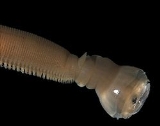
Glyceridae
Encyclopedia
Glyceridae is a family of polychaete
worms. They are commonly referred to as beak-thrower worms or bloodworms. They are bright red, segmented, aquatic worms. The proboscis worm Glycera is sometimes called bloodworm. The Glyceridae are ferocious epi- and infaunal polychaetes that prey upon small invertebrates. They are errant burrowers that build galleries of interconnected tubes to aid in catching their prey.
Polychaete
The Polychaeta or polychaetes are a class of annelid worms, generally marine. Each body segment has a pair of fleshy protrusions called parapodia that bear many bristles, called chaetae, which are made of chitin. Indeed, polychaetes are sometimes referred to as bristle worms. More than 10,000...
worms. They are commonly referred to as beak-thrower worms or bloodworms. They are bright red, segmented, aquatic worms. The proboscis worm Glycera is sometimes called bloodworm. The Glyceridae are ferocious epi- and infaunal polychaetes that prey upon small invertebrates. They are errant burrowers that build galleries of interconnected tubes to aid in catching their prey.
Characteristics
- Pointy snout used for burrowing in sediment
- No septa in anterior part of bodies
- Rely on peristalsis to move
- Explosively evert pharynxPharynxThe human pharynx is the part of the throat situated immediately posterior to the mouth and nasal cavity, and anterior to the esophagus and larynx. The human pharynx is conventionally divided into three sections: the nasopharynx , the oropharynx , and the laryngopharynx...
into sediment, anchor position with prostomiumProstomiumProstomium is the first body segment in annelid worms. It is in front of the mouth, being usually a small shelf- or lip-like extension over the dorsal side of the mouth. It sometimes bears antennae and eyes. It often functions like a kind of overlip when the animal is feeding...
and pull body forward. - Eversible pharynx also used in prey capture: 4 poisonous fangs

